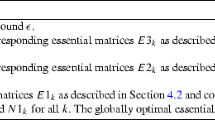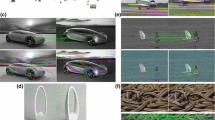Abstract
There is a close connection between the calibration of a single camera and the epipolar transformation obtained when the camera undergoes a displacement. The epipolar transformation imposes two algebraic constraints on the camera calibration. If two epipolar transformations, arising from different camera displacements, are available then the compatible camera calibrations are parameterized by an algebraic curve of genus four. The curve can be represented either by a space curve of degree seven contained in the intersection of two cubic surfaces, or by a curve of degree six in the dual of the image plane. The curve in the dual plane has one singular point of order three and three singular points of order two.
If three epipolar transformations are available, then two curves of degree six can be obtained in the dual plane such that one of the real intersections of the two yields the correct camera calibration. The two curves have a common singular point of order three.
Experimental results are given to demonstrate the feasibility of camera calibration based on the epipolar transformation. The real intersections of the two dual curves are found by locating the zeros of a function defined on the interval [0, 2π]. The intersection yielding the correct camera calibration is picked out by referring back to the three epipolar transformations.
Similar content being viewed by others
References
Deriche, R., and Faugeras, O.D. 1990. Tracking line segments. Image Vis. Comput. 8:261–270.
Faugeras, O.D. 1992. Three-Dimensional Computer Vision. MIT Press: Cambridge, MA.
Faugeras, O.D., and Toscani, G. 1986. The calibration problem for stereo. Proc. Conf. Comput. Vis. Patt. Recog., Miami Beach, FL, pp. 15–20.
Faugeras, O.D., and Maybank, S.J. 1990. Motion from point matches: multiplicity of solutions. Intern. J. Comput. Vis. 4:225–246.
Faugeras, O.D., Luong, Q.-T., and Maybank, S.J. 1992. Camera selfcalibration: theory and experiments. Proc. 2nd Europ. Conf. Comput. Vis., Lecture Notes in Computer Science 588:321–334. Springer-Verlag: Berlin, Heidelberg, New York.
Fulton, W. 1974. Algebraic Curves. Mathematics Lecture Note Series. W.A. Benjamin: Reading, MA.
Hartshorne, R. 1977. Algebraic Geometry. Graduate Texts in Mathematics. Springer-Verlag: Berlin: Heidelberg, and New York.
Hesse, O. 1963. Die cubische Gleichung, von welcher die Lösung des Problems der Homographie von M. Chasles abhängt. J. Reine Angew. Math. 62:188–192.
Horn, B.K.P. 1986. Robot Vision. MIT Press: Cambridge, MA.
Kruppa, E. 1913. Zur Ermittlung eines Objektes aus zwei Perspektiven mit innerer Orientierung, Sitz.-Ber. Akad. Wiss. Wien. Math. Naturw. Kl. (Abt. IIa. 122): 1939–1948.
Maybank, S.J. 1990. The projective geometery of ambiguous surfaces. Phil. Trans. R. Soc. London Ser. A. 322: 1–47.
Semple, J.G., and Kneebone, G.T. 1952. Algebraic Projective Geometry. Clarendon Press: Oxford. Reprinted 1979.
Semple, J.G., and Roth, L. 1949. Introduction to Algebraic Geometry. Oxford University Press: Oxford. Reprinted by Oxford Science Publications, 1958.
Sturm, R. 1869. Das Problem der Projektivitiät und seine Anwendung auf die Flächen zweiten Grades. Math. Ann. 1: 533–574.
Tsai, R. 1986. An efficient and accurate camera calibration technique for 3D machine vision. Proc. Conf. Comput. Vis. Patt. Recog. Miami Beach, FL, pp. 364–374.
Walker, R. 1962. Algebraic Curves. Dover: New York.
Wolfram, S. 1988. Mathematica: A System for Doing Mathematics by Computer. Addison Wesley: Redwood City, CA.
Author information
Authors and Affiliations
Rights and permissions
About this article
Cite this article
Maybank, S.J., Faugeras, O.D. A theory of self-calibration of a moving camera. Int J Comput Vision 8, 123–151 (1992). https://doi.org/10.1007/BF00127171
Received:
Issue Date:
DOI: https://doi.org/10.1007/BF00127171




